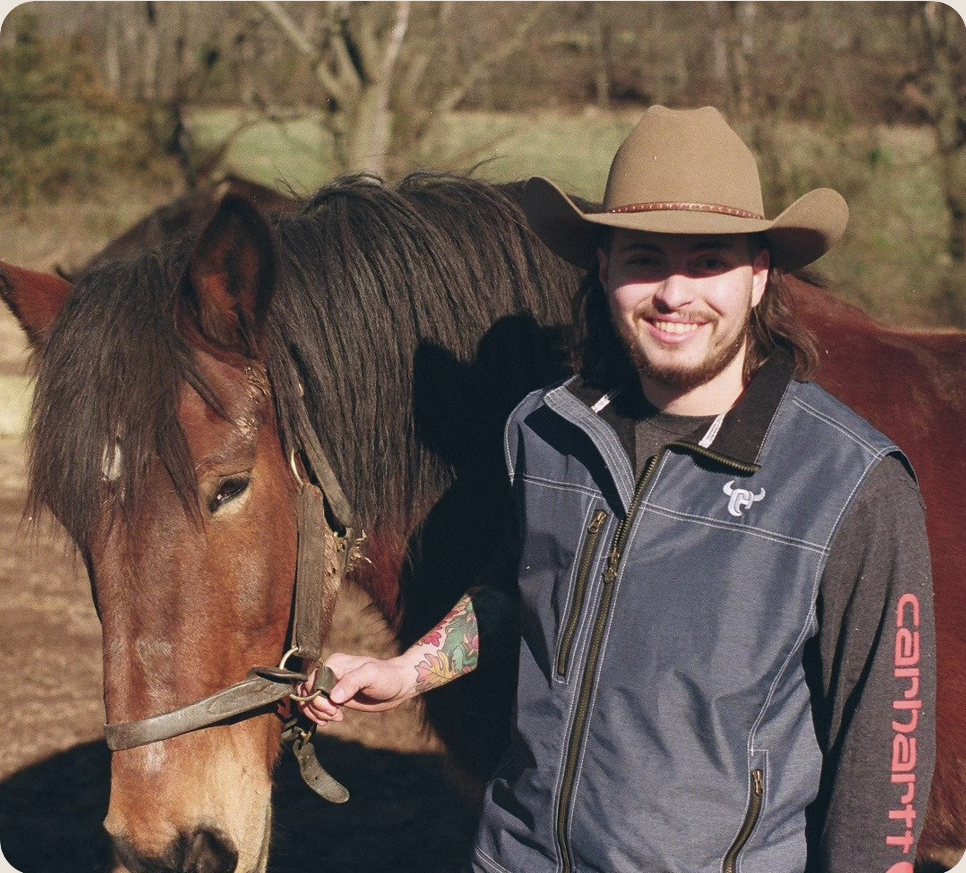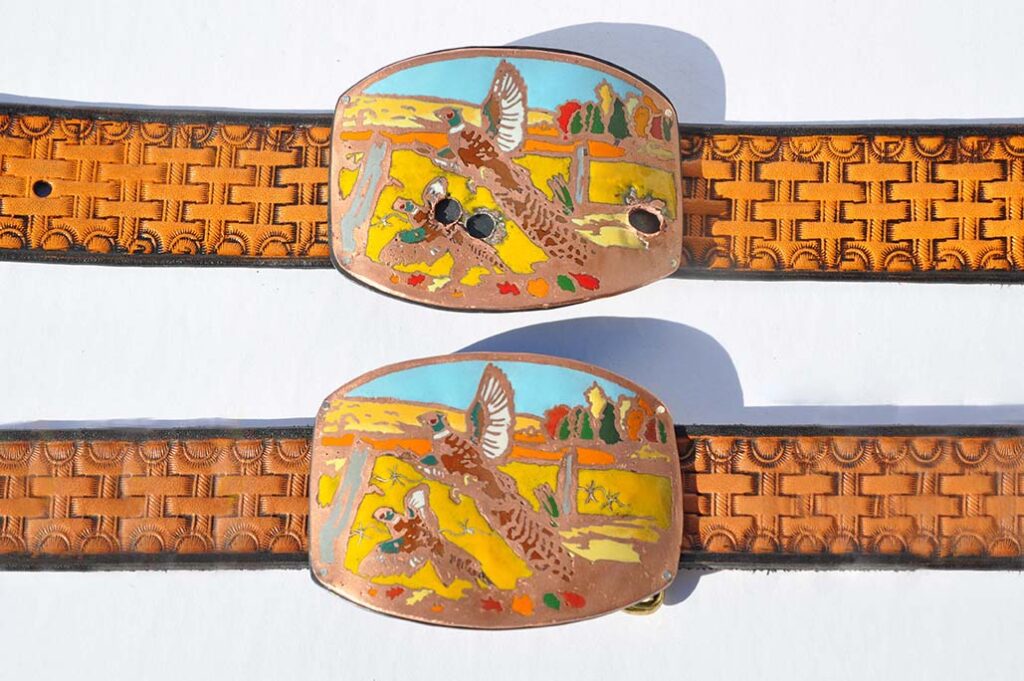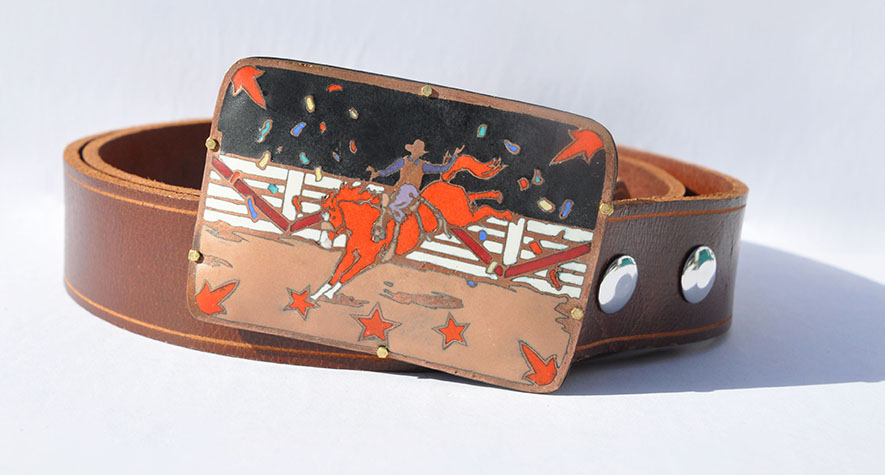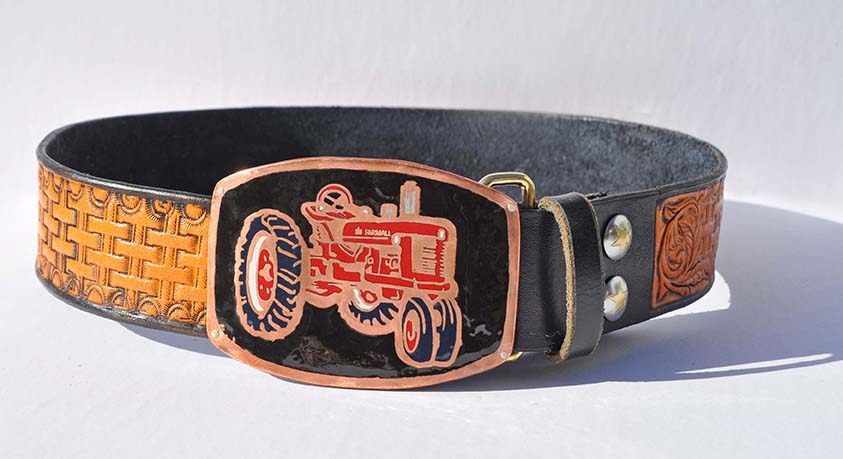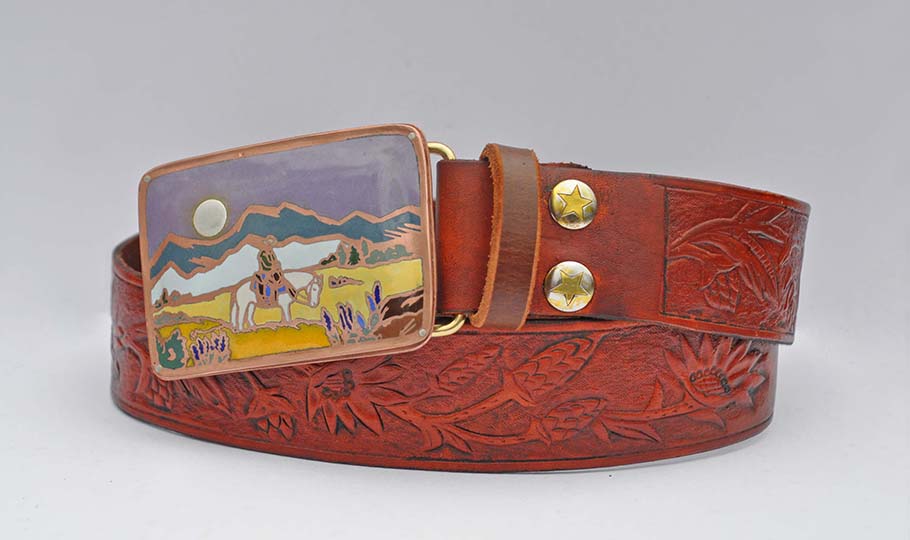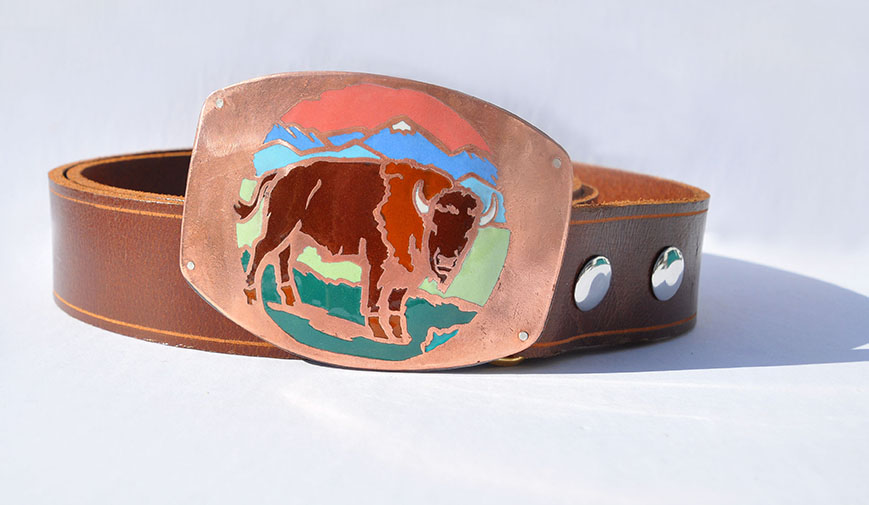
Please describe your work:
The majority of the pieces within my body of work are belt buckles and bolo ties. Since making my first set of four belt buckles while pursuing my undergraduate degree, I’ve become very enamored with this form of adornment. I’ve focused on the kinds of pieces I want to be making and have spent countless hours refining my mechanisms and findings while pushing myself to branch out from custom commissions to production style work.
Belt buckles as an art form have deep ties to American Western imagery and iconography, which are very prevalent in the agricultural world I often find myself in. Fabricating belt buckles appeals to my own interests by creating these characterizations of narration in a form of body adornment so often masculinized and tied to rural identity. The culture of farming and agriculture is commonly thought of as something reserved for conservative, cisgender, white, heterosexual people. Growing up in a small rural town, working with horses my whole life and participating in FFA and 4H, farming and agriculture grounded me.
In this work I utilize a variety of techniques such as champlevé enameling and traditional bench work. The imagery I invoke is heavily influenced by the rural American wilderness and impact the agricultural revolution had on traditional farming practices. Most of the scenes within my pieces are based off of photos that I’ve taken at a Living History Farm where I’ve worked managing their teams of draft horses and other livestock. While not all of my pieces are based off of photos, I sketch many small studies from photos I’ve taken both on the farm, at rodeos or of the barns, farms and fields of my hometown.
What is your background and training?
I initially began my college education as a painting major at The Pennsylvania Academy of the Fine Arts. I ended up transferring schools to Tyler School of Art and that’s when I began taking more diverse classes within their curriculum and it led me to taking a Jewelry 1 class. I was months away from graduating from the program as a painting major but I needed a credit in another studio class to graduate. I ended up taking that Jewelry 1 class, loving it and finally feeling a sense of direction in what I wanted to be making and knew I needed to switch majors. I then spent 3 years completing my BFA in Metals, Jewelry CAD CAM and with the guidance from all of my professors and grad students, became very dedicated to making this into my career.
During my time in this undergrad program, two of my instructors exposed me to the world of Craft Schools. During my senior thesis year I began looking into programs at Craft Schools, unsure of where it would lead me but interested in finding out. With graduation on the horizon I applied to an assistantship program straight out of college along with a few metals focused jobs. Unfortunately I was having a lot of medical issues that year and had to have a very intense surgery which left me with unexpected complications surrounding my mobility. I was not in a great place after that and at that time I did not receive the assistantship. Though looking back now it was for the best and I’m glad everything worked out the way it did. That summer and fall I focused on working for a production company in Philly, making enameled pins and badges, while taking time to go to physical therapy 3 times a week to get my mobility back on track. It was a difficult time but this led me to apply to a fall residency at Peters Valley School of Craft. I received the residency and quit working for the production company. I was only at Peters Valley for 2 weeks in the fall of 2021, but this time gave me a chance to make my work and find out what I wanted my work outside of college without guidance from a program would look like. There was a sense of community there that I loved, and I was able to take things slow, familiarize myself with a different metals studio and learn from the Artist Fellow and other Metals Resident.
When the opportunity arose in the following spring I applied for the assistantship again, though this time with a better idea of the place, people and space. I used all of the pieces I made during my residency period there to apply and received the assistantship. Working at a place like Peters Valley for the summer offered an amazing amount of growth to my skills as a jeweler. I was mentored by the Artist Fellow and was able to assist visiting instructors and students while assisting in shop maintenance, repairs and dedicating time to work on my own work. At the end of the season I returned back home to work for a Living History Farm, as my other main passion in life is farming and agriculture. During the fall and winter I prepared to apply as the Artist Fellow to run the studio space. This past year 2023, I ran the Fine Metals studio as their Artist Fellow and Studio Coordinator. I am forever grateful for this experience as it connected me with so many artists, instructors and even helped me make connections to teach at other craft schools which I got to do this past year. I was lucky to have assisted Aurelie Guillame at Penland this past summer, and while cloisonné is not my main passion, I learned a great deal from working with her and have even begun implementing cloisonné into my champlevé pieces. Overall I have found that my education outside of college has been just as essential to my growth and career as a jeweler as my time in undergrad was.
Where is your studio and how does it affect your work?
My studio has moved around quite a bit since I graduated from Tyler in 2021. Initially adapted a small section of my room into a studio where I could enamel and do bench work while soldering outside. This was not ideal but I was able to make some work, albeit while facing a lot of issues with lacking equipment. I then moved a set up into part of the garage so I could solder, etch and do bench work out there while keeping the enameling upstairs in my room. This was also not at all ideal, as everything was extremely spread out. Once I moved to Peters Valley I brought mostly everything with me and acquired more tools and some equipment through meeting other jewelers which eventually were integrated into my home studio.
My father has helped me immensely in setting up and renovating a studio space in the basement where I could begin to do all of my work once I moved back home at the end of the season at Peters Valley. I’m extremely lucky to have a father who is not only a geologist but also an electrician, plumber and overall handyman who helped me pour a concrete floor and begin setting up a space. My current studio space is in our house in what used to be the crawlspace that my father dug out, leveled and cemented. I was able to acquire an old, amazing double jewelers bench which I do bench work on one side and enamel on the other. I set up my kiln on a (locked) rolling cart and was able to buy a few affordable benchtop fume extractors for soldering and enameling. While not everything is perfect in my space, it works just fine for me and I’ve been able to make work just as I did both in school and while at Craft Schools.
What is your favorite tool. How does it influence your production?
It’s definitely expected of me to say my kiln as an enamelist, though it is such an integral part of my practice. During the pandemic when classes shifted to being at home, I scoured the internet for used enameling kilns and was able to come across a programmable Rio Kiln which was the first piece of equipment in my home studio. I have in the past done some torch fired champlevé, though always preferred being able to use a kiln to do so. In regards to equipment, my kiln is my favorite piece of equipment that I own.
What are your inspirations and biggest influences?
Most of my inspiration comes from traditional western painters such as Mark Maggiori, and Peggy Judy. Coming from a painting background, I always loved seeing the detailed work of painters who were able to capture the landscapes, people and animals in such a colorful and realistic way. Jamie Wyeth, whose paintings of farm life and the rural American wilderness has always been a huge inspiration to me while I was growing up. As a child and young adult, my parents and I would frequent the Brandywine Museum where the Wyeth family has most of their work. Jamie’s paintings always stood out to me, especially how he depicted landscapes and livestock. While my own work is more stylized, akin to old western comics, I have a deep appreciation for painters such as Maggiori, Judy and Wyeth.
Has your practice changed much over time? Do you experiment a lot or do you work within a specific set of parameters?
With the ways in which I make my work, I have definitely tried different methods over the years in regards to fabrication. Initially when I first started making belt buckles, I would do them one at a time and really just concentrate on that one piece. Now I’m usually working on 5-12 pieces at a time, all at different stages in the process. Because I do champlevé through etching and etching takes quite a bit of time, I now etch pieces in larger batches. This allows me to etch 4-8 pieces while having buckles that were freshly etched that I can prepare for enameling while also working on pieces that I’ve begun to wetpack. The enameling is really the least time consuming part of the process. Wetpacking always goes rather quick, and if I have an extremely detailed piece it can take up to 25 minutes to pack enamel in for one layer. The biggest change I’ve made this past year with my work has been breaking up the kinds of commissions I take on. I have belt buckles I make because I had an idea in mind for a design and really just make them for myself or to later enter in exhibitions. These pieces are usually more detailed scenes and can include cloisonné wire and several intricate details on the backing. These one off pieces are typically the only one of that design unless I decide to make a set of related work that go together. Then I have custom pieces that I do for clients, which are usually western scenes, or of someone’s horse or most recently I’ve been receiving a lot of tractor and vehicle commissions. I love getting to work with people one on one and design and create a piece that we’re both excited about. Up until 2023 I had not done any production lines of my work, as I assumed it would take both a long time and there would be little interest. Contrary to that belief, I have received a lot of messages on different social media platforms from people just wanting a nice, serene western design featuring a horse, bison or landscape. Sometimes people don’t know what they want until they see it in a piece. Making the Mallard Moon and Buck Moon belt buckles this fall was a great exercise for me and really helped elevate the ways in which I can refine and smooth out the fabrication process. This year, I decided to start a small line of Western Scene belt buckles, mostly just to have inventory for events such as the American Craft Council’s Craft Show this spring, but also to become more comfortable producing work by a deadline and practicing uniformity so all the pieces look identical.
What are you working on now?
Currently I’ve been preparing for the American Craft Council Show in Baltimore, and so I’ve been working on a variety of production pieces for that. This past winter in early 2024 I designed and began working on a series of four champlevé buckle designs that I’ve been reproducing and turning into a production line. When it comes to belt buckles, I’ve primarily stuck to custom commissions and making them for my own enjoyment. This past fall I had my first experience of making a small limited batch of belt buckles for two craft fairs. I was able to create 10 pieces, 5 of each design. Though to make the process quicker for fabrication, I made static bars instead of the hinged pressure fit ones I utilize in most of my work. I much prefer the feel of the hinged ones even though it takes longer to make. For this new production line I decided to do all hinged tension fit bars, for comfort and to elevate the pieces in their daily wearability. I wear a belt buckle every day, and the tension fit bars are my ultimate go to for wearer ease and long term wear.
Along with all of the belt buckles I’ve been making, I’ve also started doing production lines of different bolo tie designs. Most of these pair with belt buckles in the new series, and feature mini scenes of those designs.
What are some current trends you see in enameling and how do you feel about them?
I have definitely seen a lot of metalsmiths recently exploring enameling, getting excited about it and starting to work with color in their pieces which honestly I think is a great thing. In regards to trends I feel as though I often see a lot of graphite on enamel work, and while I personally never really got into it I do enjoy seeing people try new things out with different methods. Another technique I’ve seen a lot of lately is working with overglazes to add sharp black lines to pieces. Personally I love the illustrative aspects of it and when done cleanly, it can really add and enhance detail. I’ve tried overglazes in a few pieces, especially earlier on when in college, and again this past summer while at Penland. It’s definitely a fun way to implement text, details or doodles into a piece, though I don’t think it’s something I’ll be implementing within my champlevé work. I especially enjoyed using overglazes while exploring cloisonné, especially to add lettering and even details on the backs of pieces.
What is the best piece of enameling advice you’ve ever gotten?
Using diamond hand pads to stone while ultimately ditching alundum stones (except for a few pieces where I need to reach a certain area) has been the best piece of advice. Sharon Massey shared some links with me a few years back on diamond hand pads and it has made my life so much easier when stoning down pieces. I also was introduced to these flex shaft diamond wheels by Aurelie Guillame this year and have added those into my arsenal of tools. They have been extremely life changing and time saving to my practice. While I don’t usually work with transparents, I worked with them a lot during my time as a production enamelist for a company in Philadelphia. Both opaques and transparents I was taught to wash, and while this isn’t something most people do, I have found that washing my opaques has made such an immeasurable difference in the vibrancy of my work. In the past year I have begun to work more with leaded colors through acquiring some from a retired enamelist. After going down a rabbit hole of resources to find more and different leaded colors, I have stocked up on so many and use at least 1-5 leaded colors in my work now. Aaron P Decker has shared many resources with me on finding more leaded colors and working with them, and I have been extremely grateful for this guidance.
Who are your favorite artists/enamelists? (what are your most important influences)
In the field of metalsmithing, I’m definitely most drawn to the work of other enamelists. Especially when I see work that I’m not 100% sure how they achieved a certain effect or where there’s amazing craftsmanship and just the cleanest most gorgeous enamel.
Aurelie Guillame is one of my absolute favorite contemporary enamelists. Her work with cloisonné is not only amazing, but she is a fantastic instructor as I learned while getting to assist her at Penland this summer. I love narrative pieces, especially those that create characters and tell stories, or have recurring characters and motifs through a body of work. Seeing her enameled pieces in person was amazing, and her sharing her sketches with the class was extremely inspirational. The act of drawing and sketching is an integral part of my own practice, as I use my sketchbook as a journal as I feel most artists and enamelists do.
Another enamelist whose work I’ve been obsessed with since I saw his pieces in a slideshow in my undergrad Color in Metals Class is Zachery Lectenberg. Champlevé will probably always be my favorite enameling process, and seeing his work really helped show me what was possible with Champlevé as someone who was once just learning to enamel. I love that he draws and doodles on both the front and back of his pieces and creates characters that tell stories with personality in a comic book reminiscent style. Much of my own work is inspired by comics, primarily old 1940s western comics such as Black Fury and Gene Autry. I admire his work in that he has such clean, crisp lines and craftsmanship while also sticking to a palette of opaque colors. Personally with my own pieces, I prefer opaque enamels over transparents, especially to achieve the visual effects that I want.
Jill Tower is an enamelist whose work I’m always in awe of. I absolutely love the gradients she is able to achieve with transparents and the accuracy in her depictions of different birds and wildlife. As someone whose every other piece has a horse in it, I always love seeing artists’ depictions of animals; especially when they are akin to natural and scientific illustration. Something unique that she has done in her work that I’ve loved getting to see pictures of online is her recreations of landscapes in enamel based off of picture jasper stones. Picture jasper is my favorite stone for the reason many people like it- it looks like miniature landscapes. Seeing Jill’s new series of enameled picture stones has been amazing, and I always love seeing what she is working on.
Harlan Butt is one of the most inspirational enamelists whose work I’ve adored since learning about the art of enameling. I’m so glad I was able to see an artist talk with him through EGNE on zoom last year. Getting to see his process with jigs for laying out cloisonné, the trivets and ingenious ways he is able to fire his work and enamel in the round, and how he implements technology by using laser cutting to lay foils has been a testament to his amazing craftsmanship. The vessels he is able to fabricate and then enamel upon are absolutely amazing and never cease to amaze me.
Do you have a dream project that you’ve always wanted to do?
Currently I’ve been working on commissions and a small production line of pieces. I’m definitely at a point where I’m figuring out what I want to make next, as my last few large series wrapped up this past winter with the Fair Game buckles and the completion of the Rodeo Series. I do see myself adding more scalloped belt buckles into my future work, and carrying on the Farm Series of pieces based off of photos from my work at the Living History Farm. I’ve been wanting to design a piece featuring oxen, and I definitely see that happening this year. I’ve also wanted to start adding more flush set stones into my work. While I’m not skilled at all at stone setting, it has been a fun element to add to my more metal heavy enameled pieces where there is more negative space than color. A project I’ve wanted to find a way to do for a while has been making and getting belt buckles for country musicians that I’m a fan of. I’ve wanted to design a piece based off of Charley Crockett’s new single $10 Cowboy ever since it was released. Crockett always sports unconventionally colorful buckles on stage and getting a piece to him would be amazing to accomplish.

